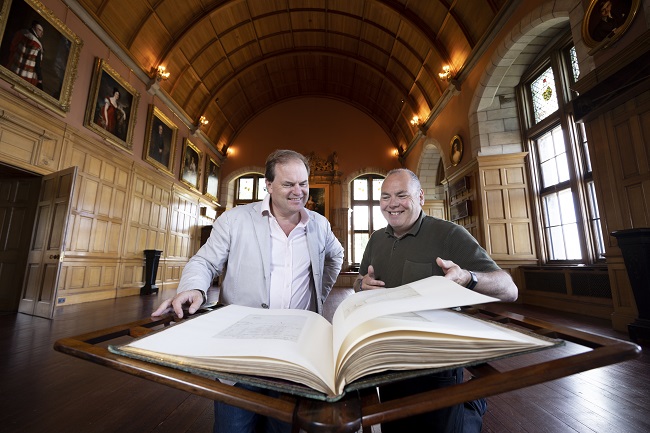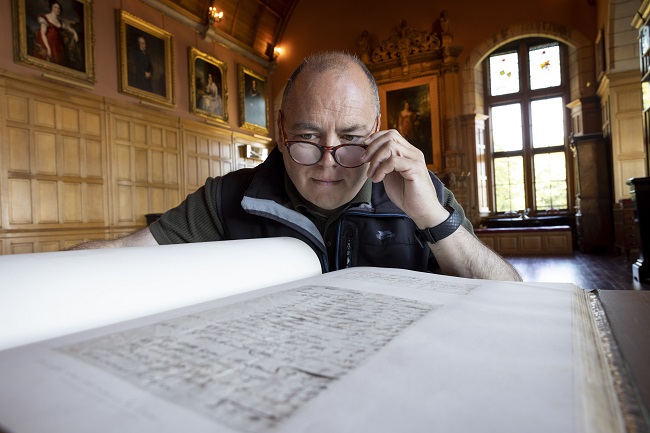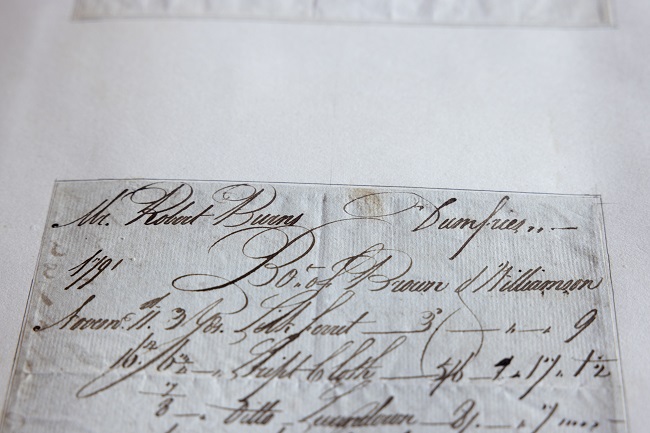University of Glasgow experts reveal fascinating new insight into Robert Burns domestic life
Published: 23 January 2023
An astonishing discovery found at a 13th century Scottish castle has shed new light on the day-to-day domestic life of Robert Burns and his family, academics at the University of Glasgow have revealed.

An astonishing discovery found at a 13th century Scottish castle has shed new light on the day-to-day domestic life of Robert Burns and his family, academics at the University of Glasgow have revealed.
The academics from the University’s Centre for Robert Burns Studies were invited to Barnbougle Castle near Edinburgh by the Rosebery family to look at a collection of rare Burns manuscripts and books collected by one of their ancestors.
While at the castle undertaking research for the Oxford University Press edition of The Works of Robert Burns they were shown an “unexpected bonus” of a book labelled simply Burnsiana.
The book - which includes Burns letters, memoranda, and trades bills - has now been loaned by the Rosebery Family to the University to allow for more detailed study and research.
Burnsiana is part of the library of the former 19th Century Prime Minister, Archibald Primrose, 5th Earl of Rosebery, 1st Earl of Midlothian, who during his lifetime amassed an excellent library which he kept mainly at Barnbougle. A keen collector, historian and writer, Rosebery was an admirer of Scotland’s national poet and did a great deal in his lifetime to protect and celebrate Burns’ legacy.
So far, the Glasgow experts who are carrying out a major project – Editing Burns for the 21st Century, led by Professor Gerard Carruthers, have uncovered a completely new “game changing” set of evidence on the building of Burns’ six apartment Ellisland Farmhouse as well as bills and receipts which show the domestic economy overseen by Jean Armour of not only his farm but his last home in Dumfries.

Professor Gerard Carruthers, the Francis Hutcheson Chair of Scottish Literature at the University and a world leading Burns expert, said: “We are so grateful to the Rosebery family for giving us access to this superb collection and in particular for lending us Burnsiana to delve even further into the materials held within it. The book contains a full set of evidence for Burns’ construction of Ellisland, previously unknown, including quantities of nails, floorboards and door frames. Here we have the minutiae of Burns constructing his first family dwelling as an adult, building both a house and a home.”
He added: “But it also paints a fascinating picture of life at Ellisland including bills for shoes, buttons and buckles to clothing materials like corduroy, calico and linen. It shows Jean Armour’s domestic economy including what foods they were growing at Ellisland with receipts for seeds including cabbage, beans and linseed to quantities of beer and honey consumed. This material is a real game changer for our knowledge of Ellisland and its future conservation.”
Dr Pauline Mackay, Co-Director of the Centre for Robert Burns Studies and Chair of Burns Scotland, said: “This exciting discovery is particularly timely as the Robert Burns Ellisland Trust look to re-develop the home Burns built into a heritage site for the 21st century.
“It will also enable us to contemplate further how we might use XR (Extended Reality) technology to compose and access important Burns-related sites, and to illuminate their evolution from the eighteenth century to the present day.”

The building receipts are from 18 September 1788 to 30 May 1789 and are titled “For Materials for a House at Ellisland”. They are from Thomas Boyd, who built the farmhouse and outbuilding, and charters the construction of Ellisland Farm over the course of eight months. Burns was especially creative during the years he lived at Ellisland writing a quarter of his songs and poems including Auld Lang Syne and Tam o’ Shanter.
Lord Dalmeny and Lady Jane Kaplan, the children of the 7th Earl of Rosebery and great-grandchildren of Archibald Primrose the 5th Earl, have been instrumental in supporting the Centre for Robert Burns Studies research into their family’s collection.
Lord Dalmeny, who is the chairman of Sotheby’s auction house in the UK, said: “The 5th Earl, my great-grandfather, rebuilt Barnbougle, which is only a short walk from our family’s Dalmeny House, into the ultimate "shed at the bottom of the garden" which included six libraries. He was a keen collector and historian, with a passion for reading and learning and some of his vast book collection, including Burnsiana, are still housed at Barnbougle.”
Lord Dalmeny added: “My great-grandfather was a Robert Burns enthusiast and admirer who during his lifetime amassed a wonderful collection of Burns materials and artefacts. This enthusiasm for Burns is well documented in the 5th Earl’s writings and speeches. But it is only through the expertise of the team at the University of Glasgow that today we realised the full significance of the Burnsiana book collect by my great grandfather – a significance we are sure the 5th Earl would have known but unfortunately this knowledge died with him in 1929.
“It is very exciting for his family to continue our great grandfather’s work helping ensure that Burns’ legacy is protected for further generations. It is marvellous to see that 226 years after his death, Burns scholars continue to reveal new and fascinating details of the life of Scotland’s national poet.”
Joan McAlpine, Business Development Manager, Robert Burns Ellisland Trust said: “This incredible discovery has come at the perfect time for Ellisland as we prepare to unveil a masterplan to develop it as a world class heritage attraction. We want to recreate the domestic setting the newlywed Burns and Jean Armour enjoyed, so finding their shopping lists is wonderful. We plan to replant a kitchen garden just as it looked in the 1780s so knowing which seeds they planted is perfect.”
Barnbougle Castle
Barnbougle Castle is a historic tower house on the southern shore of the Firth of Forth, between Cramond and Queensferry, and within the parish of Dalmeny. It lies within the Earl of Rosebery's estate, just north-west of Dalmeny House. Although its history goes back to the 13th century, the present castle is the result of rebuilding in 1881 by the 5th Earl of Rosebery, who served as Prime Minister from 1894 to 1895.
Learn more about Barnbougle here which is now run by the Rosebery Estate as an Events venue.
Ellisland Farm
Robert Burns took over the lease of Ellisland Farm on Whitsun 1788. But he did not begin farming work until 11 June 1788. Ellisland had no farmhouse or farm buildings and Patrick Miller provided Burns with £300 to build one, construct the byre, cart shed, etc. and to stock the farm and enclose the fields.
Robert had formally married Jean Armour on 20 March,1788. While Robert lived on the farm, his wife Jean and their two-year-old son Robert would not move into the fam until June 1789. The family moved to Dumfries from Ellisland in 1791.
Learn more about Ellisland here – www.ellislandfarm.co.uk
The 5th Earl of Rosebery and Robert Burns
Irvine Burns Club - founded on 2 June 1826 and is one of the world's longest continuously active Burns Clubs – made Archibald Primrose, 5th Earl of Rosebery, an honorary member in 1886.
The Irvine Burns Club website state the reason that the 5th Earl was made an honorary member “was his admiration for Robert Burns. In 1882, he had unveiled the statue of the Bard in Dumfries…In March 1885, Rosebery, while Lord Privy Seal and First Commissioner of Works, had unveiled the national monumental bust of Burns (sculpted by Sir John Steell, RSA) in the Poets' Corner of Westminster Abbey…
“On 21st July 1896, the anniversary of the poet's death, while leader of the Liberal party, he gave, at Glasgow, an eloquent "Tribute to Robert Burns" and another address at Dumfries…In 1906, Rosebery was active in a campaign to save the "Auld Brig o' Ayr". Burns clubs throughout the world contributed to a fund, and Rosebery reopened the bridge in 1910.
“In 1913, the Burns Glenriddell MSS* were bought by John Gribbel of Philadelphia, who asked Rosebery to decide to which Scottish institution they should be donated. Gribbel gifted them to the Scottish National Library under terms which ensure that they will remain in possession of 'the people of Scotland for ever'. In 1921, when Rosebery published his "Miscellanies, Literary and Historical", Burns was the subject of chapter 1.”
*The Glenriddell Manuscripts are two volumes of poems and letters by Robert Burns and are the single largest collection of Burns's manuscripts in existence.
First published: 23 January 2023
<< News

